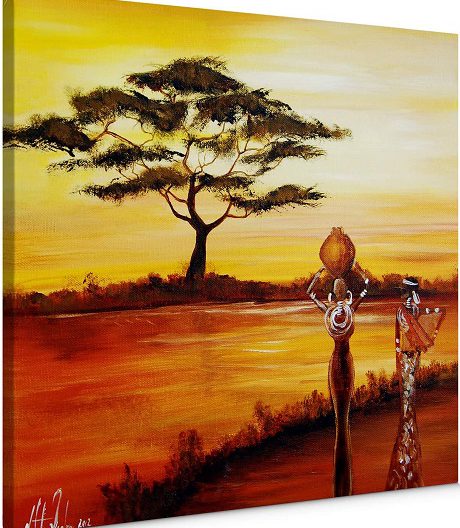
Artistic expression is no doubt one of the critical attributes of being human. There are perhaps two most important functions of human communities anywhere in the world. The first is that men need to produce the means of material existence in order to live as human beings while the second may be engaging in artistic activities as a reflection of their conscious survival or their materially productive lives.
As a corollary of this, every human community, nation, country, region or continent has its specific artistic creations with which it is distinguished from the men and women next door. Art, besides being a creative endeavor in its own right, is also a process by which identities are shaped, histories are written and meaning is given to human existence in general. Art is also a common attribute of humanity as it is also a tool with which we differentiate one community from another and a marker of economic activities that humans living in certain geographic areas are engaged in.
Art has thus, anthropological significance as “the study of all aspects of human life and culture. Anthropology examines such topics as how people live, what they think, what they produce, and how they interact with their environments. Anthropologists try to understand the full range of human diversity as well as what all people share in common.” Art is therefore one dimension of human existence and that is why we are talking about European art, African art, Chinese art, Russian or Ethiopian art. Every art has something in common with other arts while it keeps its distinguishing features that are shaped through history.
Marxists say that men should eat before they engage in politics. Although men should engage in material production in order to secure the food and other necessities they need, they have also to engage in artistic creativity in order to meet the needs of their creative existence. Which one comes first is not important unless we want to into the egg or hen first dilemma.
Artistic production is consequently one of the most primitive forms of human creativity at a time when material existence was at its primitive stage.
African art is therefore the totality of “modern and historical paintings, sculptures, installations and other visual culture from native or indigenous Africans and the African continent.” African art is so broad and varied that it is nearly impossible to put it under one single rubric bore because it is the totality of artistic productions of hundreds of millions of people living in a distinct geographic area. Nevertheless, it is technically possible to identify the specific areas in which African art shines. According to available information, it is most famous for the sculptures and masks, textile design and manufacturing.
According to some sources, “African Art and Architecture, works of art and architecture created on the African continent south of the Sahara. The immense Sahara acts as a natural barrier, separating African cultures to the north from those to the south. Although there has always been some intermingling of peoples on the two sides of the Sahara, differences in history and culture are pronounced.” This distinction is relevant because art north of the Sahara generally belongs to Arab arts due to its proximity with the Middle East and Berber or Arab influence and is known in some literature as Islamic art.
The point here is not about analyzing the two sides of the same coin, or the northern and southern faces of the same African art. The issue is rather how African art emerged and how it developed and distinguished itself from the art of other peoples and regions.
To begin with, African art has a history that spans over 10,000 years with evidence of artistic expressions dating back to prehistoric times. Ancient African civilizations such as Egypt, Nubia, and the Kingdom of Kush produced exquisite works of art, including sculptures, jewelry, and pottery. African art is so vast and diverse that it would be impossible to describe all of them in such a short article. Hundreds if not thousands of books, studies and researches have been conducted and African art is not still exhaustively understood or known.
The second point is diversity of African art that distinguishes it from the arts of other regions or peoples. “African art encompasses a wide range of styles and techniques reflecting the diversity of cultures and traditions across the continent. One of the most well-known styles of African art is the mask which has a significant cultural and religious significance in many African societies.”
One of the characteristics that Distinguishes African art from other arts is the deep symbolism and significance that it reflects. African art has thus two dimensions, namely forms and meanings. According to one sources ,the symbolism and significance of African art in the following way. “African art is often rich in symbolism and holds significant cultural and spiritual meanings. Many African artworks are created for religious or ceremonial purposes and they have believed to have spiritual powers or serve as intermediaries between the physical and spiritual realms. Masks for example are used n African rituals and performances to respect deities, ancestors and spirits and they are believed to embody their powers and protect the community.”
African art does not exist in the vacuum but coexists with other arts and cultures although it did not develop parallel to them. What differentiates African art from other forms of art is in the specific purpose it serve. For instance, African art differs from European art in the sense that, “African art, unlike most European art, generally serves a function. The art may satisfy an everyday household need, adorn the body, or fulfill a social or religious role. These objects of use also have artistic value because skilled artisans have designed and created them with a strong concern for visual beauty and symbolic meaning. “
Among the varieties and expressions of African art, masks occupy a dignified and special place for their functions and symbolism. “Masks are worn during festivals, celebrations, and ceremonies whose purposes are to cleanse, honor, entertain, initiate, or bless. A mask serves both to disguise and to protect the wearer, who is most often male, as he performs in dances or theatrical skits. Most masks are carved of wood, although some are made of cloth and other materials. They may be decorated with paint, beads, cloth, or raffia.”
African masks have deeply influenced the surrealist, such as cubism, tradition in European art and its most celebrated practitioner of African masks in his works is Pablo Picasso, who single handedly elevated it to an unprecedented artistic status. “African artists invented the aesthetics that would later inspire the so-popular Cubists styles.” According to another source, “The influence of African masks on European modern art has more recently been recognized as significant and it has been established that artists such Pablo Picasso were heavily influenced by the aesthetic of these masks.”
In this sense, some writers and art critics consider that African art has indeed influenced European art basing their observations not only on African masks but also on African art and architecture in general. Thus, they came to the conclusion that, “In the 20th century, African art has greatly influenced much Western art and the concepts of beauty that underlie it. For centuries, however, exposure to African art had little effect on European art.
The concepts behind African art-its function in ritual and its emphasis on abstract patterning rather than representation-made it so foreign to European sensibilities that many Europeans did not consider it art at all. In the 20th century, a search for new artistic forms led European artists to look anew at the abstract forms of African art.”
This assertion was later on supported by other observations by the same art critics who saw in African art a greater scope of influence on European art. “Wider recognition of the artistic value of African artifacts began in the early 20th century. Western artists at that time sought to break free from established artistic conventions, and in doing so they rediscovered African sculpture. Their enthusiasm for African art was based on form; Western artists had only vague and romanticized ideas about the cultures that had produced the art.”
Despite available and concrete evidence of the influence of African art on European modernism, there are still remnants of the old school of European art that tend to deny this influence because in their views African art is still primitive and unable to be put on a par with its European counterpart. These are Eurocentric or biased views proving that colonial and neocolonial views and prejudices are not completely extinct from Europe.
The fact that some of the most celebrated European modernist artists admitted that some of their most important works had been inspired by African art that can claim the mantle of modernity in its own right. “Spanish artist Pablo Picasso’s Les demoiselles d’Avignon (1907, Museum of Modern Art, New York City) is probably the best-known Western painting inspired by African art. It features a group of female figures whose angular forms and large facial features resemble African masks. Although Picasso denied any African influence on this painting, his friend and colleague André Derain wrote that he introduced Picasso to African art in 1905, and Picasso himself later spoke of the strong impression African art had made on him.”
Africa is not only famous and influential with its traditional arts and architecture. There are also young and upcoming modernist artists who are using the African art legacy in order to create and recreate the continent’s greatness and originality on the canvass as well as on the building designs they are imagining and implementing. it would be safe to say in this context that while European modernism is something passé African modernism is just starting to shake the global art world, reflecting Africa’s artistic renaissance. The long journey has only just started.
BY MULUGETA GUDETA
THE ETHIOPIAN HERALD SATURDAY 18 NOVEMBER 2023




